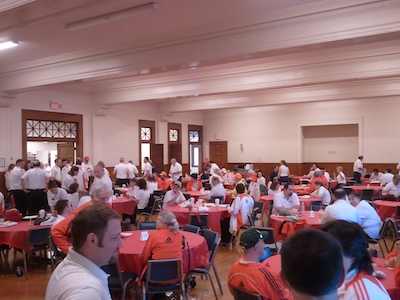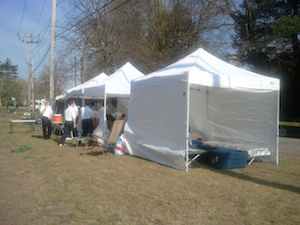
April 26, 2012
Ham Radio and the Boston Marathon
You have to be one dedicated ham radio operator or possibly a fool to wake up at 3:30 am to drive in the dark of night to Boston, MA.
That's what it takes to be one of the 100-plus ham radio operators that provide mission-critical communications for the American Red Cross First Aid stations that are spread out across the 26.2 mile world-famous Boston Marathon course.
Just ten months prior I worked my first public service ham radio event and instantly became hooked on helping at events like the marathon. Public service events are fun, exciting and put your radio skills to the test. You need to be able to work under pressure, in any weather and be able to stay focused on what your job really is - to communicate.
When I signed up to volunteer for the Boston Marathon, I thought it would be not much different from the events I worked last summer. Suffice it to say I was wrong. The Boston Marathon is perhaps the premiere ham radio public service event in the USA. As my mentor Lee Hillsgrove, Sr., KB1GNI said, "It's as close to working a real disaster as you'll ever find." That's an understatement.
 The day started with an organizational meeting that convened at 6:45 am. You need to attend, because this is where you get the coveted jacket that each volunteer has to wear. Different volunteers get different colored jackets. This helps both the runners and those working at the first aid stations to quickly locate by sight key personnel. This year the ham radio operators wore a vivid orange jacket with black stripes on the sleeves.
The day started with an organizational meeting that convened at 6:45 am. You need to attend, because this is where you get the coveted jacket that each volunteer has to wear. Different volunteers get different colored jackets. This helps both the runners and those working at the first aid stations to quickly locate by sight key personnel. This year the ham radio operators wore a vivid orange jacket with black stripes on the sleeves.
Since the forecast was for record heat, and Mother Nature didn't disappoint, my jacket was tied around my waist all day. No way was I going to wear it with the temperature hovering a few degrees below 90 F.
The Boston Marathon is put on by the Boston Athletic Association, but they get enormous help from the American Red Cross. We ham radio operators were actually volunteers for the Red Cross, and as such were asked to wear clothes that meet their uniform requirements. Dark navy-blue or black pants and a white shirt are the dress code. Fortunately we were able to substitute dark shorts to keep us cool in the heat.
 After the organizational meeting, everyone scatters to their assigned locations. It's now time to test the radios and call into net control. We quickly discovered at our first aid station, # F12 at mile 18.3, that we couldn't get in on the frequency we were assigned. The other two hams at my station decided that we needed to upshift and go to the next higher frequency. It worked perfectly.
After the organizational meeting, everyone scatters to their assigned locations. It's now time to test the radios and call into net control. We quickly discovered at our first aid station, # F12 at mile 18.3, that we couldn't get in on the frequency we were assigned. The other two hams at my station decided that we needed to upshift and go to the next higher frequency. It worked perfectly.
Because there's so much radio traffic during the race, and the course is run in a straight line from Hopkington, MA to downtown Boston, MA, you need at least seven or eight frequencies to make it all work. After all, a 5-watt HT handheld radio can only reach so far and daytime propogation can wreak havoc as well. What's more, you want certain segments of the course on one frequency. Having all hams on the same frequency would create radio gridlock.
Because we were fairly far down the course, we didn't see our first activity until late morning. That's when the wheelchair racers streak by. About 30 minutes later, the elite women ran by as if they were on a Sunday stroll.
Then it started to get more crowded. The elite men racers blazed by us followed closely by the first wave of runners. Then the floodgates opened.
Commonwealth Avenue looked like the busiest airport concourse you've ever seen. It was impossible to cross the street to get to a runner in distress without impeding a runner or getting run over. If it was necessary to get onto the course to aid a runner, we were instructed to merge into the flow of runners much like you merge into traffic entering an interstate highway.
The first aid station I worked at was staffed by real pros. Teams were assigned to do all sorts of first aid and evaluate runners in distress. Two mobile teams were created to assist runners that were down and in trouble on either side of our station. Each time one of these teams was dispatched, a ham radio operator went with them in case they needed help.
Bedlam erupted as wave two and three of the runners trudged by our station. At three different times, our first aid station was over capacity. I had to call in for seven ambulances to take runners to local hospitals.
Our most serious case was a runner carried into our station totally unresponsive. He was suffering from heat stroke, and was stabalized only after being put into a cold-water soaking bath.
The advice I received prior to the race from Lee was invaluable. One thing you absolutely must have is a lapel microphone and earphones. You can't count on being able to hear the speaker in your HT over the crowd noise. What's more, I found it very handy to have one earbud monitoring the radio frequency and my other ear listening for requests from our first aid station supervisor.
You also have to have all the equipment one might need to be totally self-sufficient for the entire day. This means food, water, batteries, spare radio, clothing for any weather, chair, etc. I discovered that it's really smart to bring with you anything you might take on a three-day camping trip, including all sorts of tools, a step ladder, rope, nails, screws, great duct tape, plastic, etc.
The day ended about 5 pm, and I was beat. Not only did the heat suck at my strength, but the mental stress of being on your toes to help others for six straight hours sapped me as well.
If you've never worked a public service event before, I don't know that I'd start with the Boston Marathon. Work one or two other smaller events to get comfortable with the protocols of communicating with net control. Do what's necessary to get into shape to handle being on your feet for hours at a time.
Perhaps the most important thing to remember at all times is why you're there. What is your purpose? It's to communicate. If you get hurt, if you get distracted, if you get tired, you can become a liability instead of an asset.
The runners, the medical team at your station and those operators working net control need you to do but one thing: Be there, aware and on the air when you're needed.
Don't try to do something that's outside that scope. Don't try to be a hero. That's the job of the medical staff. If you can't communicate, everyone that's counting on you gets let down.
Oh, one more thing. I was no fool and my call sign is W3ATB. 73's!
April 5, 2012
Apple Macs Infected by Flashback Trojan Bot
A peer of mine just notified me that Apple computers are possibly infected with a trojan virus.
You can read about it on ars technica for the details.
But more importantly, here's how you check your Mac to see if you are infected. Luckily I'm not.
The first step is to open your Applications icon. And then click Utilities at the bottom of the list. See in the next column Terminal? You need to click and open that. See image below.
When you open Terminal you're going to see a window that looks like what computers looked like back in 1984. There were no fancy graphics back then. It was just text on the screen and talk about intimidating! You had to enter in text commands to get the machine to do something. No mouses!
At the bottom of this post is an image of what the Terminal window should look like on your Mac. See it below the image of the Applications window screen shot?
Now, follow these exact instructions:
Copy and paste the below line into the Terminal window behind the cursor block, then press the "Enter" key:
defaults read /Applications/Safari.app/Contents/Info LSEnvironment
Hopefully, it will output the following line:
"The domain/default pair of (/Applications/Safari.app/Contents/Info, LSEnvironment) does not exist"
Next copy and past the below line into the Terminal window behind the cursor block, then press the "Enter" key:
defaults read ~/.MacOSX/environment DYLD_INSERT_LIBRARIES
Hopefully, it will output the following line:
"The domain/default pair of (/Users/joe/.MacOSX/environment, DYLD_INSERT_LIBRARIES) does not exist"
If you do not get those exact output lines, you probably have an infection.
Go here for some help. Let's hope you're clean like I was.
Here are the screen shots of what I'm talking about:

Here's what you should see when you click the Terminal application:

